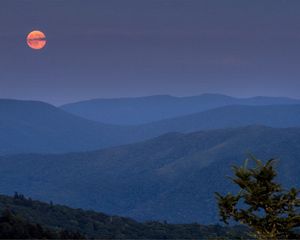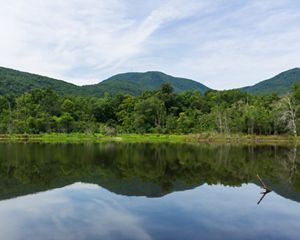
Fire and Water Kyle Worley watering down foliage with a hose during a controlled burn on North Saluda Reservoir, a primary source of water for Greenville, South Carolina. © Andrew Kornylak
Imagine a living laboratory of ecological wonders—a place sheltered from human development for generations, where plants and animals found nowhere else in the world thrive. And in the middle of it are deep, clear reservoirs holding some of the purest water in the United States.
Now imagine someone came along and set fire to this place.
That’s what Austin Williams and McKenzie Boyd do for a living. Well, it’s one thing that they do. Williams and Boyd are part of the conservation staff at Greenville Water, a utility company that provides drinking water for over half a million people in the northwest corner of South Carolina.
Most of that water comes from two reservoirs in Greenville’s strictly protected watershed areas. Perhaps counterintuitively, regular fires are required to maintain the watersheds’ ecology—and maintaining that ecology is what ensures exceptional water quality.


If you grew up in Greenville County—as I did—you may have heard that “we have the best water in the country.” I started exploring this story because I wanted to know if this was true—and if so, how it came to be that way.
I talked with the staff of Greenville Water, as well some of Greenville's city leaders, civic activists and my own colleagues at The Nature Conservancy (TNC), Greenville Water’s official conservation partner as holder of a conservation easement on the watershed properties. I learned about the history of water conservation in this region—and I learned that what we mean by “conservation” is constantly changing.
Sometimes protecting the water requires official acts by government leaders. Sometimes it requires actions carried out with lawnmowers, bulldozers and the occasional goat.
And sometimes it requires setting fires.

Water World: The Southern Blue Ridge
Greenville Water draws most of its water from the Table Rock and North Saluda reservoirs—a pair of dammed lakes located within strictly protected conservation areas near the North Carolina border. The reservoir properties, which are about 22 miles apart, are connected by a network of parks and preserves known as the Mountain Bridge Wilderness Area.
This stretch of protected land—40,000 acres altogether—sits in the Southern Blue Ridge Mountains, and it is one of most biologically diverse regions on Earth, on par with iconic places like the Amazon rainforest and the “Coral Triangle” of the South Pacific.

This exceptional biodiversity comes from the topography of the Southern Blue Ridge, which resembles a piece of paper that’s been crumpled up and only partly smoothed again. All those gorges and peaks and valleys create an array of microclimates—from lush subtropical forests to boreal habitats inhabited by plants and animals you find as far north as Maine.
And, of course, there’s water—lots of it. Copious rainfall feeds springs and streams that converge into larger rivers and eventually feed the two reservoirs. These waterways are home to a greater variety of salamanders, crayfish and freshwater mussels than anywhere else in the world, as well as the southernmost population of Eastern brook trout.
The region’s diversity even varies between Table Rock and North Saluda. “Even though they are less than 22 miles apart, there are actually very few similarities between the two watershed landscapes,” says Robert Schmidt, Chief Administrative Officer at Greenville Water. “Table Rock has more endemic species [plants and animals that are found nowhere else] but North Saluda has a greater diversity of species overall. Even the fish in the two lakes are very different.”
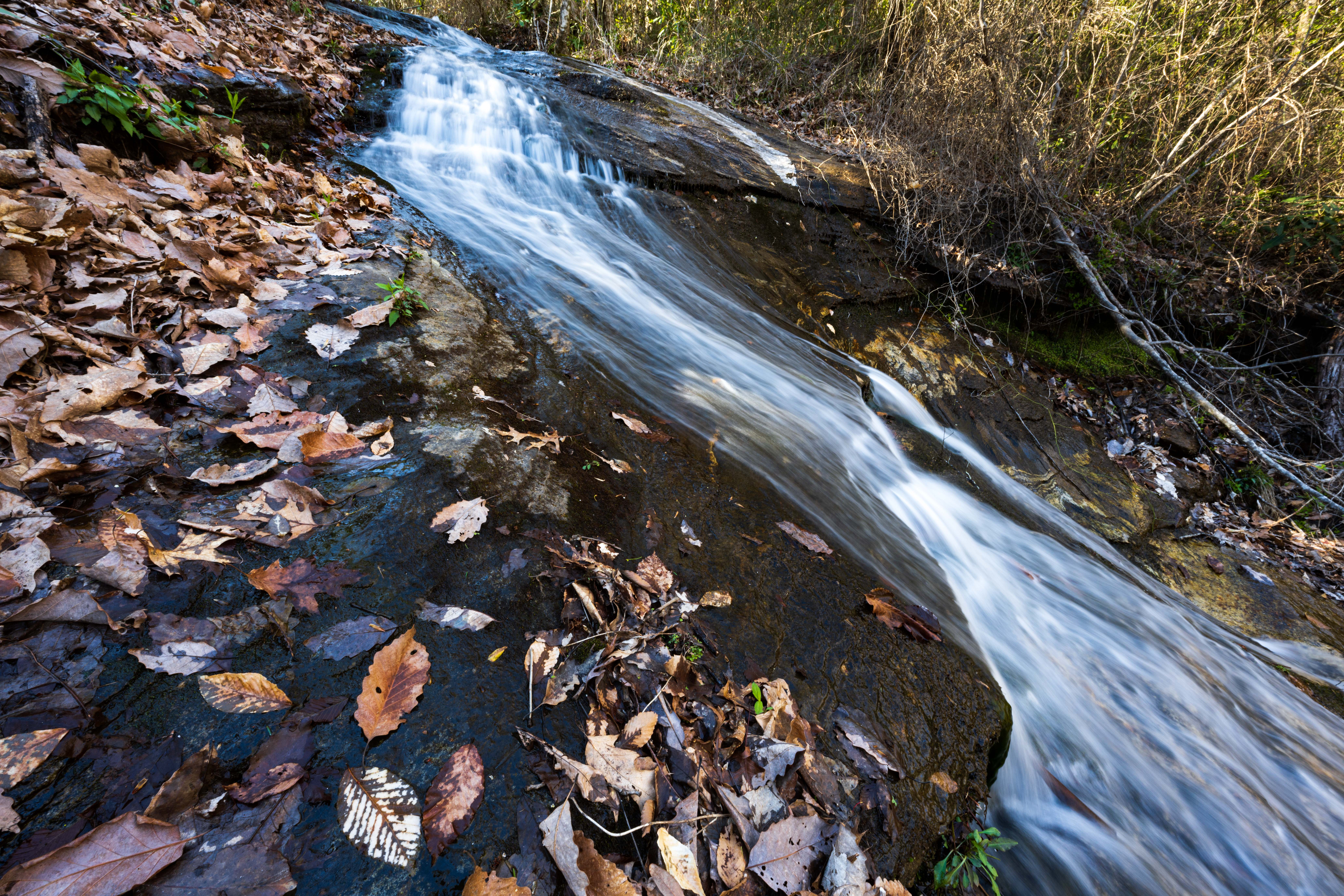
These watersheds are also exceptional in the level of protection they enjoy. To ensure the drinking water in the reservoirs remains as clean as possible, Greenville Water has restricted any public access to the properties they own, which encompasses the entirety of both reservoirs’ watersheds as well as a good deal of buffer land around them.
The lack of development near the watersheds ensures few pollutants enter the reservoirs, and the restricted access reduces the invasive species that might disrupt these ecosystems. As a result, these watersheds are some of the most pristine in the United States.
"The best water in the country"
So what my grandparents and teachers and neighbors all said was true—Greenville’s water could be considered “the best” in the United States. It’s won several awards from the American Water Works Association for the best-tasting tap water in the country. But it’s not just a matter of taste—it’s about the chemical purity.
Greenville’s treatment plants remove natural sediments from the water, but even this need is minimal. The forests and meadows throughout the watersheds do an excellent job catching sediment and filtering rainwater as it flows into the reservoir.
The fact that Greenville’s water requires so little treatment is partly why this region has some of the most affordable water in the country—extensive filtering and chemical additives increase water costs. Geography helps, too. Since the reservoirs are located at higher altitudes in the Southern Blue Ridge, gravity does most of the work to deliver water to customers.

A recipe for success (and beer)
Clean, affordable water is good for everyone, but it’s especially important for industries with heavy water use—like breweries. So I visited the Birds Fly South brewery in Greenville—purely for journalistic research, of course—to talk with owners Shawn and Lindsay Johnson about the importance of water quality for their work.
Birds Fly South has a constantly shifting lineup of beers, from traditional lagers to farmhouse ales brewed in open tanks to capture ambient flavors from the environment. And a clean water supply is essential for this, Shawn says.
“Greenville’s water is like a blank slate … When water moves through a watershed it picks up all sorts of minerals, bicarbonates and other matter that affects the flavor of the beer, especially when it interacts with the grain. And in some cities there’s spikes in some of that matter depending on seasonal changes.”
Many brewers use reverse osmosis or preboil their water to remove some of that matter, he continues. “But we have this unadulterated water supply that is constant year-round, so we're able to dial in all the other variables … and nail whatever beer style we’re focused on.”
Clean water also makes brewing operations more efficient. Clean water creates less mineral build up in their tanks, meaning less cleaning and less overall water usage. “We can be more sustainable, and it saves us money.”

Fire on the mountain: restoration and management
But restricting development and traffic alone isn’t necessarily enough to ensure healthy watersheds and optimal water supply.
That’s where fire comes in.
Much of the region was once covered by fire-adapted ecosystems—places where the natural habitats evolved with a regular cycle of fire and regrowth. And when fire is removed, it can change the character of the landscape.
Small, controlled fires clear out the forest understory, making room for grasses and shrubs. That means more diverse habitats for other plants and animals, including pollinating insects. It also ensures new generations of fire-evolved trees like oak, whose seedlings require sunlight and whose nuts feed a variety of animals.
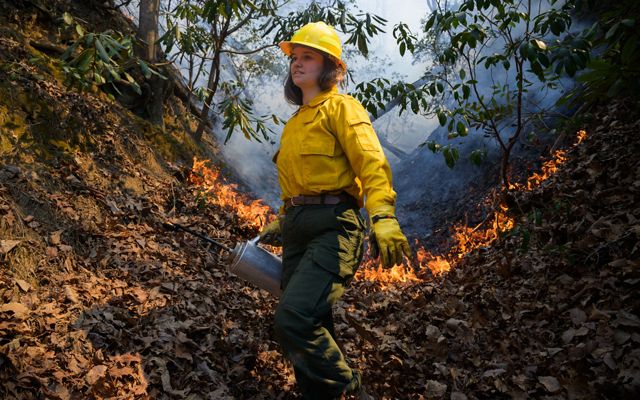

When fires are suppressed for long periods of time—as they were in the region for many years—the downstream effects add up. The overstory grows thick, making way for shade-loving trees like maple to take over. A forest dominated by maple and poplar retains more water—enough to lower reservoir levels by 5-10%—and these trees crowd out the shrubs and grasses that promote species diversity and filter water.
But the biggest danger from suppression is the risk of more extreme wildfires. In the absence of smaller, more frequent burns, forests can grow dense and build up more debris, which fuels bigger, hotter wildfires.
This what happened in 2016 when a campfire leapt out of control on Pinnacle Mountain, just a few miles from the Table Rock reservoir. Though no lives were lost, the fire burned 10,000 acres, including 7,000 acres within the watershed. All told, the fire caused $5 million in damages—the costliest fire to date in South Carolina’s mountain region.
On top of the acute safety risks, such wildfires can severely impact water quality. Scorched ground and damaged trees can’t hold soils in place, making reservoirs vulnerable to sediment runoff. And when fires burn hot enough, they can produce chemical reactions that release toxins in that sediment.
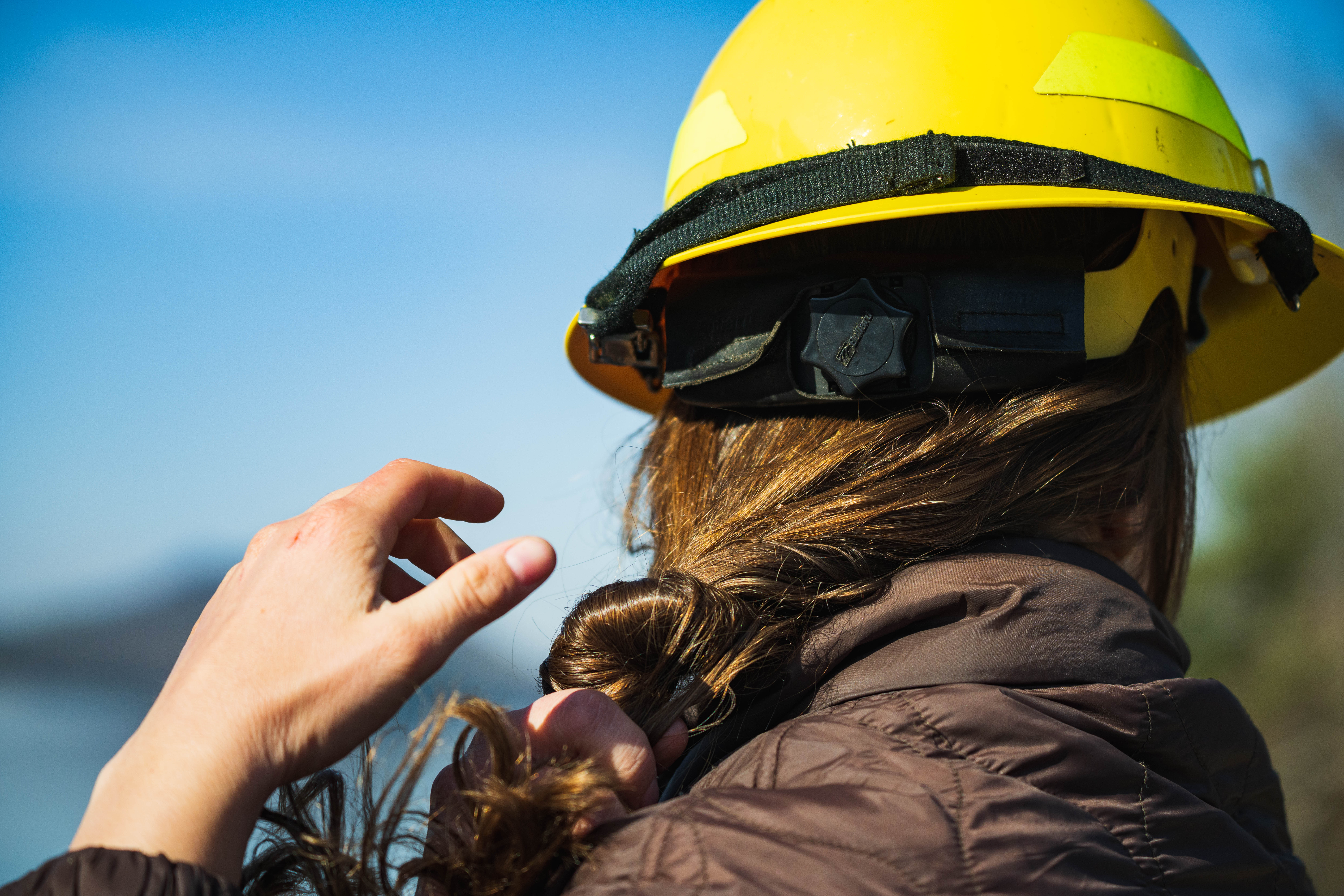
“2016 was a real wakeup call,” says Kristen Austin, Upstate Conservation Director for TNC in South Carolina. With the wildfires at Pinnacle Mountain and nearby Lake Lure, North Carolina, and an especially deadly wildfire in Gatlinburg, Tennessee and Great Smoky Mountains National Park—which all happened within a few weeks of each other in 2016—it was clear even damper regions in the Southeast were more vulnerable than previously suspected.
This lesson eventually led to the introduction of controlled burning in both the Greenville watershed properties starting in 2019. With assistance from TNC’s Fire Learning Network, Greenville Water began training its conservation managers in prescribed fire techniques, and for the past three years Greenville Water and TNC have worked together to conduct regular burns in both watersheds.
“At first I was nervous, working with fire,” says McKenzie Boyd. “But you learn to work with it—to respect it.”
Prescribed fire in action



A watershed moment: permanent protection
TNC’s partnership with Greenville Water goes back much further than their current fire work—it began over 30 years ago, when TNC became the holder of a conservation easement on the two watershed properties.
“Historically, [Greenville Water] has always been extremely protective of the water system land,” says Knox White, Greenville’s current mayor and a member of city council in the 1990s. But it was matter of company policy and historical precedent rather than anything legally binding.
That changed in 1992, when a local real estate developer approached Greenville Water about acquiring a parcel of Greenville Water land adjacent to the watershed. The utility’s partnership with the city required that any proposed sale of property on or adjacent to the watersheds be announced at open city council meetings where the public could weigh in.
And the public did, with a swift and loud “no!”

“There were letters to the editor in the paper every week, people calling city council members; a group called Waterworks formed and started showing up at city council meetings with buttons they made,” recalls White, who was one of four council members who immediately opposed the sale.
In response to the public concern, the city and the Greenville Water Commission established a Greenville Watersheds Study Committee to arrange a scientific survey of the watershed properties and make a recommendation as to whether the potential sale should be approved. The Watersheds Study Committee also took public opinion into account, reviewing a petition to block the sale (signed by 6,000 Greenville County residents) and letters sent to local papers and directly to the Watersheds Study Committee itself.
When I read these letters 30 years later, I’m stunned at their passion. Protecting the source of our drinking water is a matter of public health, some writers argue. It’s just good economics, many say. But the most common theme is that these watersheds are a priceless natural heritage—we have a duty to preserve them for future generations, these writers urge, regardless of their utility to us.
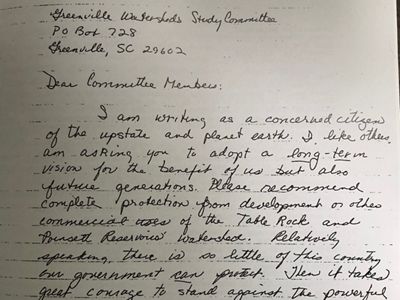
“People from other parts of the state don’t realize how important our nature is to Greenville,” says Minor Shaw, whose father, Buck Mickel, was the chair of the Watersheds Study Committee. “You always have civic differences but that's been a really important element in Greenville to bring people together.”
According to the Watersheds Study Committee, public sentiment and scientific evidence both pointed clearly to one conclusion. “From all individuals, all scientists and all groups and organizations, the feelings are unanimous and strongly held - ‘Don’t sell any of this property.’”
But while the immediate prospect of a sale was blocked, the experience showed just how fragile and temporary the current state of the watersheds was. In response, the city and the Greenville Water Commission approached TNC about protecting the watersheds permanently through a conservation easement.
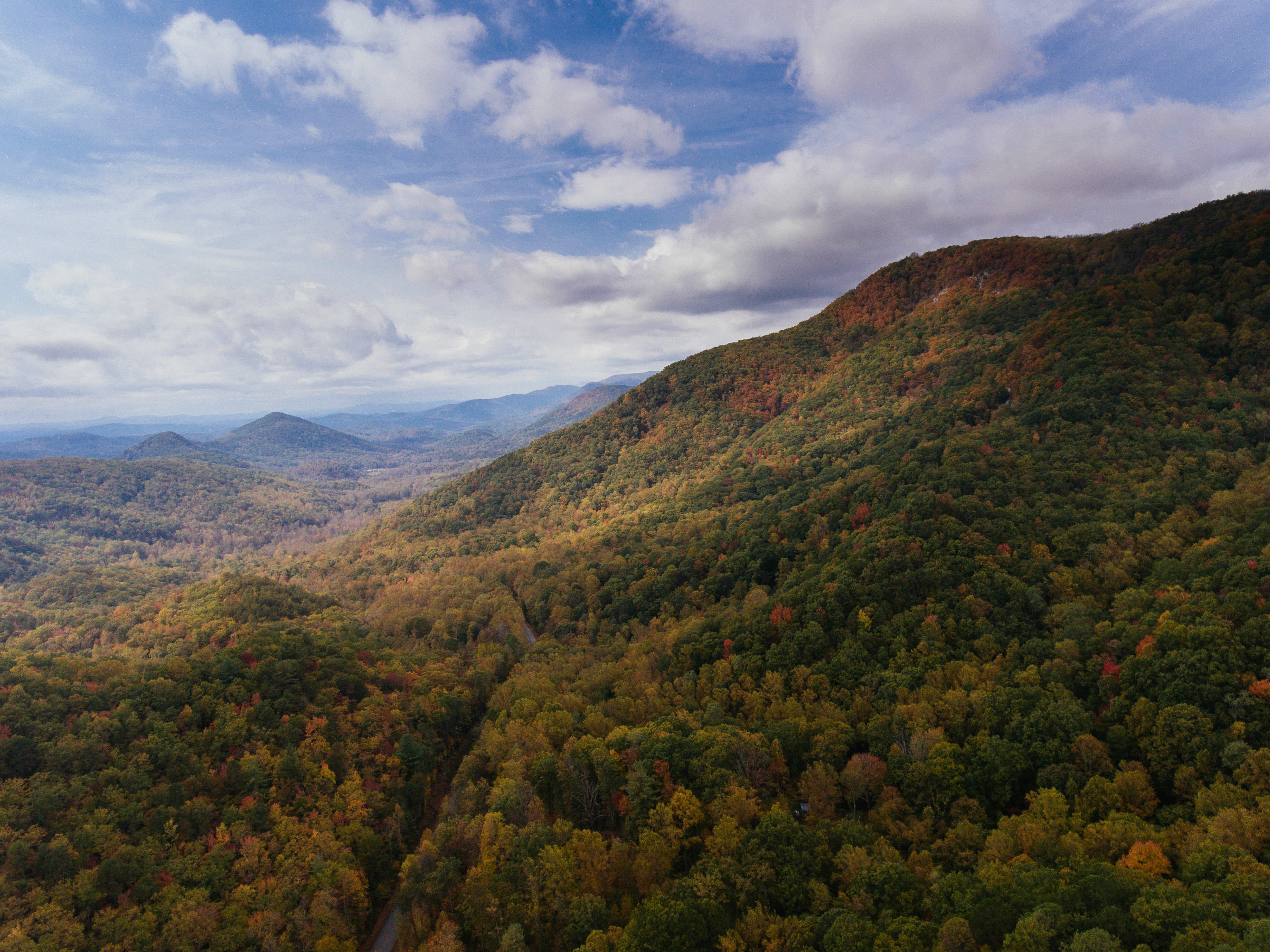
What is a conservation easement?
Conservation easements protect land for future generations while allowing owners to retain many private property rights and to live on and use their land. In these easements, a landowner voluntarily agrees to sell or donate certain rights associated with his or her property—often the right to subdivide or develop—and a private organization or public agency agrees to hold the right to enforce the landowner's promise not to exercise those rights. An easement selectively targets only those rights necessary to protect specific conservation values, such as water quality or migration routes, and is individually tailored to meet a landowner's needs.
In 1993, Greenville Water and TNC signed a conservation easement and since then, the two organizations have worked together to manage these lands for water, landscape and ecosystem health. That includes the new prescribed fire program McKenzie Boyd and Austin Williams work on—but much, much more.
When Boyd isn’t wielding a drip torch, she might be working on new strategies to control the Hemlock Woolly Adelgids—invasive, aphid-like insects—that are destroying hemlock trees in the watershed, or managing a herd of goats that eat invasive ground plants. Austin Williams is leading a brook trout habitat restoration project and working with state agencies on a plan to use the North Saluda population as breeding stock to repopulate other streams in the Southeast.
“Because these areas have been protected for so long, this is one of the last places you can find genetic strains of these fish that haven’t been influenced by introduced species,” Williams says. “That’s what’s amazing about working in such a protected area—it’s like this laboratory where you can try out different ways of doing conservation.”

Climate changes everything: conserving for the future
The 30 years since the creation of the watershed conservation easement have brought other conservation successes to Greenville. The Reedy River has been transformed from a public health hazard to the centerpiece of a revitalized downtown that generates billions of dollars in revenue. Greenville’s riverfront has been featured in national media and contributes to a reputation that draws tourists and new residents alike.
But other new residents are coming for a less cheerful reason—climate change. While many cities in the Southwest United States are still growing, historic droughts and increasing wildfires are helping to shift internal migration toward the Appalachians and other regions where prospective residents see opportunity with less environmental risk.
The Southern Blue Ridge is not immune to the effects of climate change, either, though—and that makes prescribed fire even more important as a resilience strategy.
“You get these extreme weather patterns. There’s a fire, and then right after that there’s all this rain, which causes erosion in that area where the fire was. And then you might have three months of heat that dries everything out and primes it for another wildfire,” says Ray Freeman, Greenville Water’s lead watershed manager. “We have to find ways to control those elements.”
Community conservation leaders




While water quality is the most immediate concern, quantity could be affected as climate change intensifies, says Julie Demeester, water program director for TNC in North Carolina.
“We're seeing with climate change that temperatures in the Southern Blue Ridge are increasing, and that is leading to more evapotranspiration—basically water escaping through the trees. That is going to contribute eventually to less water in our streams.”
Quote: Phillip Kilgore
Our commission takes a multi-generational approach. We're not just looking at today, tomorrow, or even five years from now. What about two or three generations?
For now, Greenville Water’s reservoirs provide ample water for the region. But they aren’t taking the current state for granted, says Phillip Kilgore, chair of the Greenville Commission, which oversees Greenville Water’s policies and finances.
“Our commission takes a multi-generational approach,” Kilgore says. “We're not just looking at today, tomorrow, or even five years from now. What about two or three generations?”
Exactly—what about two or three generations from now?
Until just 30 years ago the idea that any part of the watershed property might be developed was unthinkable—until suddenly it wasn’t. The idea that conserved lands need to be managed and stewarded—that sometimes they needed to be burned—was at one time alien, too. Actions we take for granted today were once bold choices.
I’m heartened to live in a community that protects our natural heritage—but one day we may have to reconsider what “protecting” means. What’s the next bold choice we’ll have to make?
Whatever that might be, Kilgore is confident we’ll rise to the occasion.
“No one knows the future, but I can’t envision one where these watersheds are not protected.”
Sign up for Nature Updates
Receive monthly nature news, conservation stories and updates near you. Get a preview of Nature News
